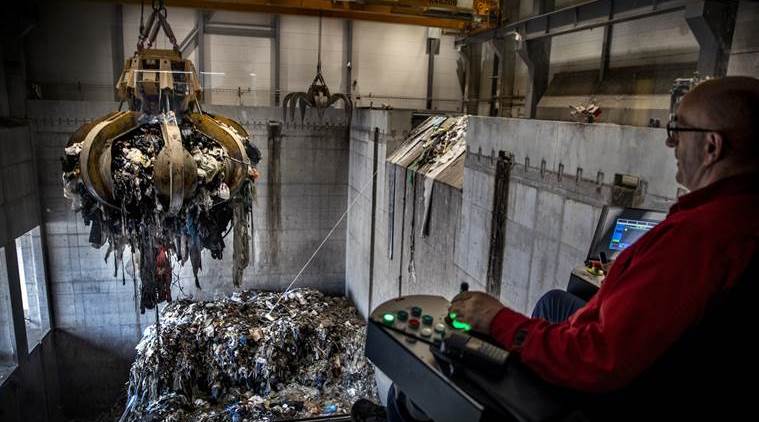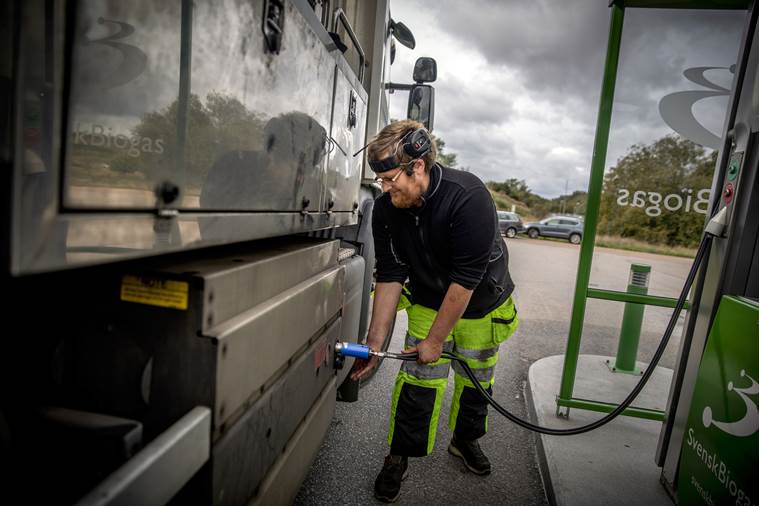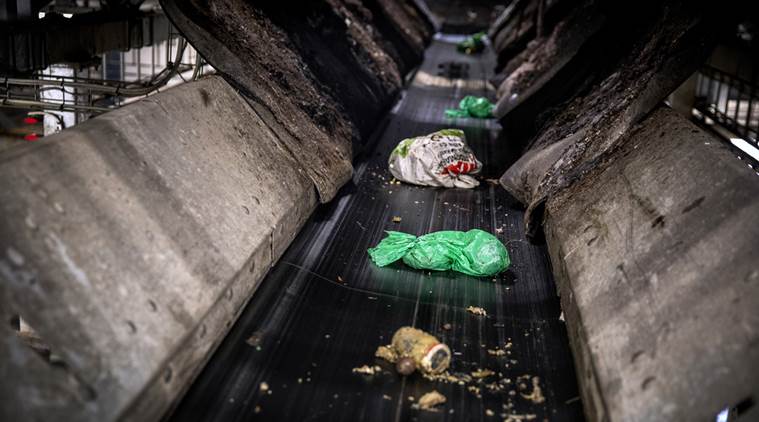In Sweden, trash heats homes, powers buses and fuels taxi fleets
However, garbage-fueled power plants are not a clean energy source. Some opponents claim these power plants are a “false solution” that greenwashes dirty incineration.

Tahir Gasanin operates the mechanical claw that feeds a power plant burner with five tons of garbage at a time in Linköping, Sweden, (The New York Times photo)
In a cavernous room filled with garbage, a giant mechanical claw reaches down and grabs 5 tons of trash. As a technician in a control room maneuvers the spiderlike crane, the claw drops its moldering harvest down a 10-story shaft into a boiler that is hotter than 1,500 degrees Fahrenheit. A fetid odor emanates from plastic trash bags discarded by hundreds of thousands of homes.
The process continues 24 hours a day to help fuel this power plant run by Tekniska Verken, a municipal government company in Linköping, a city 125 miles south of Stockholm. It is one of Sweden’s 34 “waste-to-energy” power plants. Instead of burning coal or gas, this power plant burns trash.
1m 0s

Pope warns energy bosses of global destruction without fuel shift
Pope Francis warned that climate change risked destroying humanity on Saturday (June, 9) and called on energy leaders to help the world to convert to clean fuels to avert catastrophe. Anna Bevan reports
“We don’t look at it as waste,” said Klas Gustafsson, vice president of the company. “We use the energy content of waste as much as possible.”
Four tons of garbage contains energy equivalent to 1 ton of oil, 1.6 tons of coal, or 5 tons of wood waste, according to the company.
Sweden is known for strikingly reducing the trash sent to its landfills. Less than 1 percent of household waste in this Scandinavian country finds it way to landfills, according to Avfall Sverige, the Swedish waste management and recycling association.
About 49 percent of household waste is recycled, and roughly 50 percent of garbage is incinerated in power plants like this one. Heat is transformed into steam that spins turbines to generate electricity much like conventional power plants that burn coal or gas.
Trash accounts for a small portion of Sweden’s overall power supply; hydro and nuclear energy generate about 83 percent of Sweden’s electricity, and wind generates another 7 percent.
But garbage supplies much of the heat during cold months for the country’s nearly 10 million residents. Energy from trash equals the heating demand of 1.25 million apartments and electricity for 680,000 homes, according to Avfall Sverige.
Conventional power plants typically feature large cooling towers that dissipate excess heat, so only about 40 percent of energy is fully used. The trash-powered plant in Linköping, which generates electricity and heats water for home and commercial use, harnesses 90 percent of total energy. This supplies hot water for bathrooms, kitchens and central radiator heating.
This centralized system of “district heating” warms many buildings in Sweden. The system was built over decades of planning starting in the late 1950s. “This is not something you do overnight,” said Ronny Arnberg, project manager at IVL Swedish Environmental Research Institute in Stockholm.
Trash-burning plants do have their drawbacks, such as emissions like conventional power plants fueled by natural gas and coal.
However, methane generated from organic waste in landfills is reduced. This is important. In the short term, methane is about 72 times more potent as a greenhouse gas than carbon dioxide.
From 2002 to 2005, Sweden banned organic and combustible waste (such as paper) in landfills. This is a marked change from four decades ago. In 1975 every person in Sweden recycled on average 18 kilograms, about 40 pounds, of waste per person compared with about 357 pounds in 2016. Back then, each resident also produced about 430 pounds of trash that was sent to landfills, compared with about 6.6 pounds in 2016, according to Avfall Sverige.
Along with reducing landfill, proponents say using trash as an energy supply also reduces burning fossil fuels extracted from the earth and shipped around the world using even more fossil fuels.
Tekniska Verken estimates that its trash-burning operations last year avoided emitting the equivalent of 467,000 tons of carbon dioxide.
“Waste-to-energy is a reasonable short-term solution,” said Owen Gaffney, director of international media and strategy at the Stockholm Resilience Center, which conducts environmental research. “It is less carbon intensive than coal and it uses resources more efficiently than simply putting them in landfill where they would decompose and release greenhouse gases anyway.”
Along with heat and electricity, Tekniska Verken produces methane biogas from 100,000 tons of food and organic waste each year. This biogas runs more than 200 city buses in the county, as well as fleets of garbage collection trucks, and some taxis and private cars, they report.
The entire process is on display in the company’s trash sorting facility, where garbage bags whiz by on conveyor belts.
Digital sensors detect the special green bags for organic waste. They are batted aside by machines onto another conveyor belt to be trucked to a nearby biogas plant. Machines rip apart plastic bags and organic waste is filtered into a massive metal vat. The biogas digester will create methane that is eventually refined, scrubbed of carbon dioxide and then distributed to Linköping’s fuel stations.
However, garbage-fueled power plants are not a clean energy source. Some opponents claim these power plants are a “false solution” that greenwashes dirty incineration.
“The process of burning trash is inherently polluting,” said Leah Kelly, senior attorney with the Environmental Integrity Project, a nonprofit based in Washington. “You can put state-of-the-art pollution controls on an incinerator in the same way that you can a coal plant, but that doesn’t make the facility clean.”
Flue gases leave behind heavy metals and other toxins that comprise about 4 percent of residue, according to a report from Avfall Sverige.
This must be cleaned out during periodic maintenance and treated and disposed of safely. Flue gas residue from Tekniska Verken’s power plant is stored in an abandoned lime mine in Norway.
Another residue called slag, composed of the remnants of glass, porcelain, gravel and other material, can be used to cover landfills and build roads.
Critics also warn that these power plants discourage reducing and recycling waste, and also detract from investment in renewable energy like solar and wind.
Yet Sweden is increasing recycling. The country recycled about 1.4 million tons of waste in 2011 and 1.6 million tons in 2015. The country is also increasing wind and solar capacity as part of its aim to 100 percent renewable energy by 2040 and to have net zero greenhouse gas emissions by 2045.
As lofty as those goals sound, Sweden is on track to meet them, said Gaffney of Stockholm Resilience Center. “That’s entirely realistic,” he said.
Along with its domestic production, Sweden also imports trash from Norway and Britain each year to fuel power plants. These countries pay Sweden to accept their trash because it can be cheaper than paying landfill taxes, Wiqvist said. Sweden has not run out of garbage to burn, but more plants have been built to use an available fuel source.
Waste-to-energy is also thriving elsewhere. Japan already incinerates up to 60 percent of its solid waste. China has more than doubled its waste-to-energy capacity from 2011 to 2015, according to a World Energy Council report.
Burning trash for energy seems particularly practical for large, developing nations that lack modern trash disposal systems where garbage poses a massive environmental and health threat.
In developing countries trash is typically carted to mountainlike dumpsites where methane causes fires. Such sites often lack the concrete or plastic linings found in modern “sanitary landfills” and can leach toxins into soil or water supplies. Garbage dumpsites are also serious hazards for poor people who pick through rubbish to scavenge recyclables by hand.
MORE VIDEOS
For all the latest World News, download Indian Express App
 Peter Akre fills his truck with methane biogas in Linköping, Sweden (The New York Times photo)
Peter Akre fills his truck with methane biogas in Linköping, Sweden (The New York Times photo) Mixed bags of trash move along a conveyor belt at a power plant in Linköping in Sweden, which burns trash instead of coal or gas. Digital sensors detect the special green bags for organic waste and push them onto another conveyor belt to be trucked to a nearby biogas plant. (The New York Times photo)
Mixed bags of trash move along a conveyor belt at a power plant in Linköping in Sweden, which burns trash instead of coal or gas. Digital sensors detect the special green bags for organic waste and push them onto another conveyor belt to be trucked to a nearby biogas plant. (The New York Times photo)
















































No hay comentarios:
Publicar un comentario